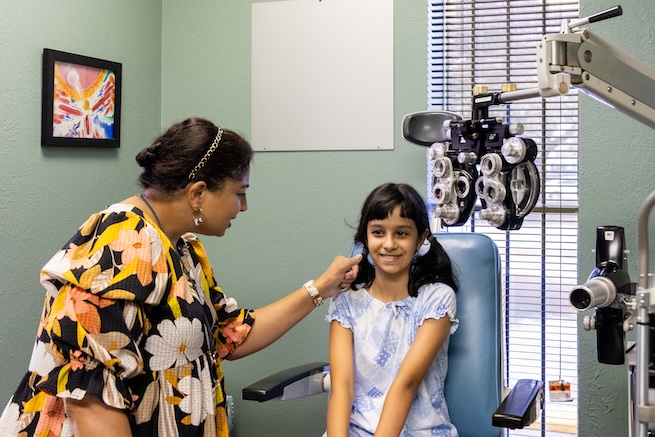Pediatric Eye Care
Support your child’s highest potential.

Healthy vision is one of the most important components of your child’s wellness.
Vision develops rapidly starting at birth and is tied to many developmental milestones, such as hand-eye coordination and reading. In the long term, your child’s vision will impact how they learn, play, and interact with the world.
While there may be some obvious signs of visual disorders, many vision problems can only be detected by a qualified eye doctor during a comprehensive eye exam.
Schedule an appointment at Vision Source on Long Point, and give your child the gift of clear vision.
Is your child having trouble seeing?
It is not always easy to spot vision problems in kids.
Some symptoms are more obvious, like squinting or holding reading materials very close. But often the early signs are subtle and can even be misdiagnosed.
Your child may be experiencing a vision problem if he or she does any of the following:
- Avoids reading and close-up work like coloring or doing puzzles
- Seems to work slow or not understand the task
- Complains of fatigue or headaches
- Has a short attention span or seems distracted
- Covers one eye or tilts head when focusing on something
- Shows sensitivity to light
- Exhibits difficulty with coordination
Common eye disorders in children
Vision can be affected by many things, including the shape of the eyeball, how the eyes and brain work together, and by other diseases or medical conditions. The good news is that many eye disorders can be successfully identified and treated.
The most common eye disorders are caused by the shape and alignment of the eyes, including:
Strabismus is when the eyes do not align properly. This is often referred to as “crossed eyes.”
Amblyopia is poor vision in one eye, and is sometimes referred to as “lazy eye.” It usually occurs before the age of eight. Infants born prematurely or with low birth weight are at greater risk.
Refractive errors cause blurry images due to the shape of the eyeball or lens. These common conditions are easily treated with glasses or contact lenses. There are three types of refractive errors:
- Myopia or nearsightedness is good close vision but poor distance vision.
- Hyperopia or farsightedness is poor up-close vision. Distant objects can easily be seen.
- Astigmatism is imperfect vision at any distance.
The Impact of Technology on Children’s Vision
In today’s digital age, the widespread use of smartphones and other devices is influencing children’s visual health more than ever.
We are seeing more and more instances where parents rely on devices as a way to keep children entertained, especially in public spaces like grocery stores. However, this heavy use of technology is having unintended consequences on their developing visual systems. The education system also heavily depends on digital devices, which compounds the issue.
Long periods of screen time—both at home and in school—can lead to early onset nearsightedness, starting as early as age 3 or 4. This condition is expected to escalate, often resulting in progressively stronger prescriptions. Even if a child has good genetics, excessive screen exposure can override those advantages, leading to greater visual challenges as they grow.
The Role of Early Detection in Preventing Vision Problems
Given the growing trend of early nearsightedness, it’s more important than ever to detect vision problems early. The visual system is still developing in young children, and as they grow, their eyes are growing, too. When they do, the prescription for their vision is likely to change as well. This makes it crucial to monitor children’s vision from an early age.
Developmental milestones in vision, such as recognizing when a child is struggling to focus or showing signs of squinting, can provide valuable clues for predicting future vision issues. Early intervention can prevent further complications and ensure that children have the best possible chance for healthy vision throughout their lives.
Best Practices for Pediatric Eye Exam Scheduling
The earlier these potential problems are identified, the more effective the treatment can be, ensuring that children can learn and grow without visual impairment. Routine eye exams are a crucial part of your child’s well-being and readiness for learning. Many parents do not know that school screenings are not the same as eye exams. Even with 20/20 vision, your child can still have problems that only an eye doctor can detect.
- At 6 Months: Dr. Pannapara recommends that a child’s first detailed eye exam should occur at six months, which helps detect issues such as cataracts or eye misalignment (eye turn) that could hinder the child’s vision development.
- At 12-18 Months: As children start reading, usually between the ages of 12 to 18 months, any issues such as astigmatism need to be addressed as soon as possible to support optimal learning and development.
- At age 3: It is crucial to check for signs of nearsightedness, lazy eye, or high astigmatism, all of which can affect a child’s ability to learn, especially when visual processing is responsible for about 80% of their early learning.
- Yearly after age 3: Regular eye exams—at least once a year—will help monitor any changes and ensure children maintain the best vision as they grow.
Support your child’s highest potential — schedule an appointment at Vision Source on Long Point today.